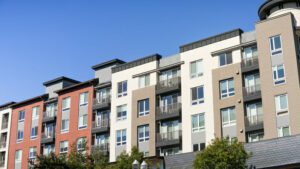Can NFPA 13D be Used for Retrofitting Mixed Use Buildings?

The following article is based on a Expert of the Day question NFSA received regarding fire sprinkler retrofits for mixed use occupancies.
By Jeffrey M. Hugo, CBO
 The idea to use NFPA 13D for other than 1- and 2-family dwellings is not new. It seems attractive to try to adapt NFPA 13D into something it is not scoped to do. The scope and purpose of NFPA 13D is for 1- and 2-family dwellings including townhouses. It does not contain the content necessary to work with the building and fire codes in mixed use buildings.
The idea to use NFPA 13D for other than 1- and 2-family dwellings is not new. It seems attractive to try to adapt NFPA 13D into something it is not scoped to do. The scope and purpose of NFPA 13D is for 1- and 2-family dwellings including townhouses. It does not contain the content necessary to work with the building and fire codes in mixed use buildings.
For example, a typical existing downtown building, with Business or Mercantile (B or M) on the first floor with vacancies on the second/third floor. The second or third floor is proposed to be built out for R-2 (apartments) or R-1 (hotel, or short-term rentals).
Sprinklers would be triggered for the R-1/R-2 work. The R use necessitates the installation of fire sprinklers throughout the building, as mandated by Section 903.2.8 of the International Building Code (IBC), which requires comprehensive sprinkler coverage due to the R use. Some developers want to use NFPA 13D throughout the Residential, Business or Mercantile areas. NFPA 13D is not appropriate in this mixed use existing building application. The 2022 NFPA 13D standard states,
This standard is appropriate for protection against fire hazards only in one- and two-family dwellings and manufactured homes. Residential portions of any other type of building occupancy or within mixed occupancies should be protected with sprinklers in accordance with NFPA 13 or NFPA 13R. Nonresidential portions of such buildings should be protected in accordance with NFPA 13 or NFPA 13R as appropriate for areas outside the dwelling unit.
 The text above, from NFPA 13D states, the B and M occupancies on the basement/1st floor should be NFPA 13R or NFPA 13. Why? The 2022 NFPA 13R standard states,
The text above, from NFPA 13D states, the B and M occupancies on the basement/1st floor should be NFPA 13R or NFPA 13. Why? The 2022 NFPA 13R standard states,
The standard is appropriate for use as an alternative to NFPA 13 only in those residential occupancies, as defined in this standard, up to and including four stories in height above grade plane. This standard references NFPA 13 in many aspects (e.g., hanging and bracing, design densities and spacing outside of dwelling unit, painting and finish of sprinklers, welding).
Buildings that contain multiple occupancies (either separated or nonseparated), accessory occupancies, or incidental uses are often subject to special rules that might restrict the use of this standard. In buildings containing a residential occupancy properly separated from other occupancies, the use of this standard in the residential occupancy and NFPA 13 protection levels in the nonresidential occupancy(s) is appropriate…
NFPA 13D and Mixed Use Buildings
Some key differences and implications of trying to use NFPA 13D in mixed use buildings:
- NFPA 25: Currently, the NFPA 13D system does not have to comply with NFPA 25. This means, the R-2, B, and/or M uses sprinkler system will never be required to be maintained.
- Supervision: The 13D system does not require water-flow alarm and tamper switches, as required by NFPA 13R and NFPA 13 systems.
- Duration: The NFPA 13D water duration is 10-minutes versus the 30-minute supply in NFPA 13R and in NFPA 13 for light hazard occupancies.
- FDC: A fire department connection is not required by NFPA 13D. If one is installed, then PEX tubing is not rated for the increased pressures.
- Outside the dwelling unit criteria: NFPA 13D does not have criteria for the non-residential areas, such as the B and M areas, whereas NFPA 13R and NFPA 13 does.
- Design: The NFPA 13D designs considers up to two sprinklers flowing versus the up to four sprinklers flowing in NFPA 13R.
- Cost: Each NFPA 13D dwelling unit would need its own riser, whereas one riser of NFPA 13R can typically cover the entire building. It can be said, with the multiple 13D risers, it could cost more than NFPA 13R.
Can NFPA 13D Apply to Fire Sprinkler Retrofits in Mixed Use Buildings?
In conclusion, while NFPA 13D is a recognized standard for the IBC, its scope and development have been restricted to single- and two-family dwellings. A more appropriate standard for retrofitting an existing downtown building would be NFPA 13R or NFPA 13.
Have a Codes Question? Ask NFSA’s Expert of the Day
NFSA members enjoy many benefits, and one of the most valuable resources is our Expert of the Day (EOD) service. Members submit their toughest real-world questions about sprinkler design, installation, inspection, testing, and maintenance (ITM), and more. Our fire NFSA sprinkler experts respond with accurate and accessible answers about code, standards, and technology. Contractors and Authorities Having Jurisdiction (AHJs) alike use this resource to solve complex problems.
For more information on Expert of the Day, or to join the NFSA, visit our membership page.
